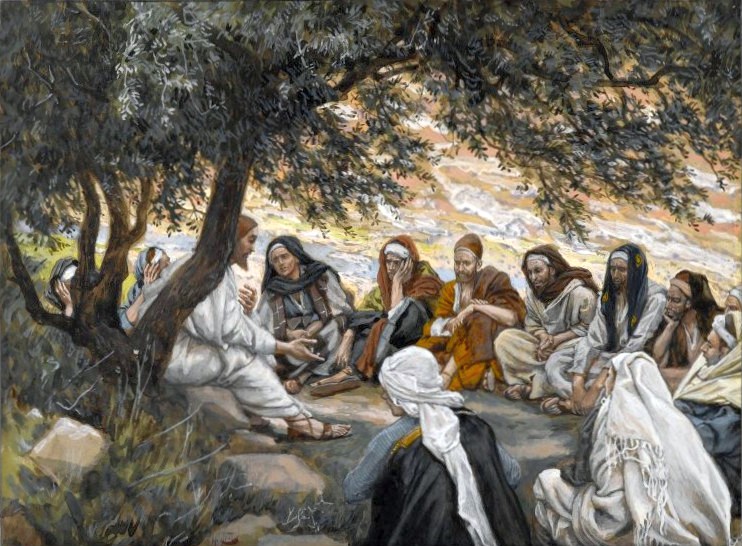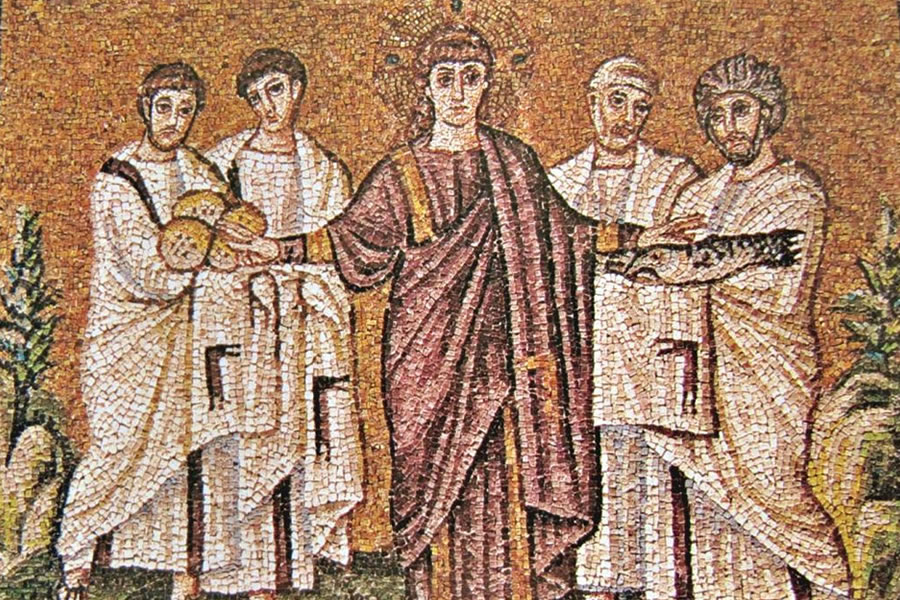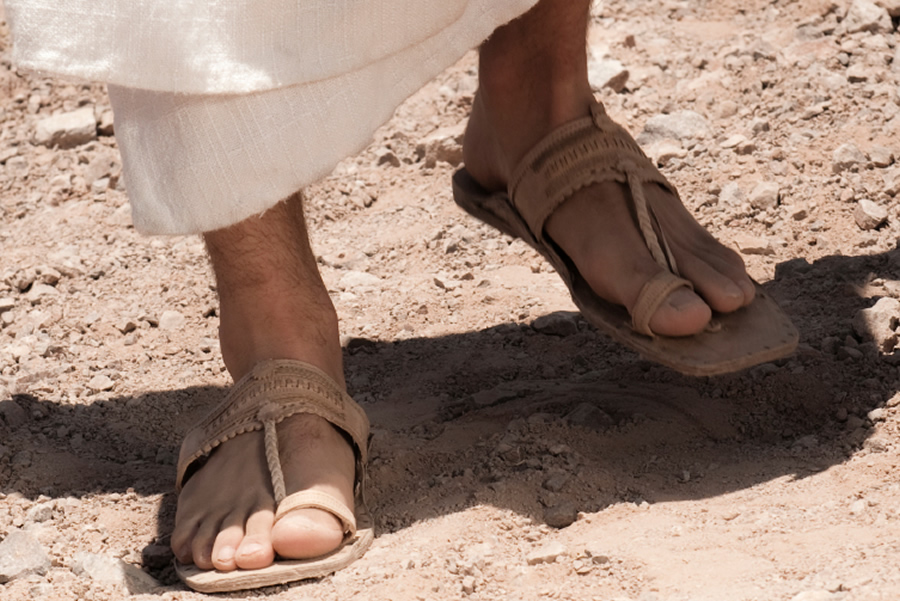St. Francis of Assisi Weekly Reflections

Are You Living the Word of God?
08-29-2021Weekly ReflectionWe Celebrate Worship Resource, Vol. 46, No. 3God’s word exhorts us to action, as we hear in the Letter of Saint James, “Be doers of the word and not hearers only” (1:22). Listening to the word of God is essential, but it is not enough. All three readings today can guide us. Moses tells the Chosen People that they must observe the commandments carefully, not only to keep the covenant, but also as a model for other nations, for outsiders will look upon their conduct and see the wisdom and worthiness of their laws. However, by the time of Jesus, the Word made flesh, the Pharisees and scribes were more about outward appearances than internal character. Jesus enumerated a baker’s dozen of sins that emerge from a person’s heart. Elsewhere he speaks of the conduct expected of someone who will inherit eternal life: treating your neighbor as yourself; feeding the hungry, welcoming the stranger, and visiting the sick and imprisoned; making disciples of all the nations. Let us not just listen to God’s word but go and live the word of God in all that we do.
How can you be a “doer of the word” in your daily life?
¿estas Viviendo La Palabra De Dios?
La palabra de Dios nos exhorta a la acción, como oímos en la Carta de Santiago: “Pongan en práctica esa palabra y no se limiten a escucharla” (1:22). Escuchar la palabra de Dios es fundamental, pero no es suficiente. Las tres lecturas de hoy pueden guiarnos. Moisés le dice al Pueblo Elegido que debe observar los mandamientos cuidadosamente, no solo para guardar el pacto, sino también como modelo para otras naciones, porque los forasteros verán su conducta y verán la sabiduría y el valor de sus leyes. Sin embargo, en la época de Jesús, el Verbo hecho carne, los fariseos y los escribas tenían más que ver con las apariencias externas que con el carácter interno. Jesús enumeró una docena de pecados de un panadero que surgen del corazón de una persona. En otra parte habla de la conducta que se espera de quien heredará la vida eterna: tratar al prójimo como a uno mismo; alimentar a los hambrientos, acoger al extraño y visitar a los enfermos y presos; haciendo discípulos de todas las naciones. No solo escuchemos la palabra de Dios, sino que vayamos y vivamos la palabra de Dios en todo lo que hacemos.
¿Cómo puedes “practicar la palabra” en tu vida diaria?
Doers of the Word
08-29-2021Question of the WeekReading I: Deuteronomy 4:1-2, 6-8 — Advantages of Fidelity
Reading II: James 1:17-18, 21b-22, 27 - Response to God's Gift
Gospel: Mark 7:1-8, 14-15, 21-23 - Jesus and the Pharisees
Key Passage:
Welcome with meekness the implanted word that has the power to save your souls. But be doers of the word, and not merely hearers who deceive themselves. (James 1:21–22)
Adults: Which words of Jesus provide the most inspiration for the Christian work that you do?
Kids: How do you welcome the words of Jesus into your heart?
Practicantes De La Palabra
Lectura I: Deuteronomio 4: 1-2, 6-8 - Ventajas de la fidelidad
Lectura II: Santiago 1: 17-18, 21b-22, 27 - Respuesta al regalo de Dios
Evangelio: Marcos 7: 1-8, 14-15, 21-23 - Jesús y los fariseos
Pasaje Clave:
Acepten dócilmente la palabra que ha sido sembrada en ustedes y es capaz de salvarlos. Pongan en practica esa palabra y no se limiten a escucharla, engañándose a ustedes mismos. (Santiago 1:21-22)
Adultos: ¿Qué palabras de Jesús proporcionan la mayor inspiración para el trabajo cristiano que realizas?
Niños: ¿Cómo acoges las palabras de Jesús en tu corazón?
Christian Marriage
08-22-2021Question of the WeekYour title here...
Reading I: Joshua 24:1-2a, 15- 17, 18b — Reminder of the Divine Goodness
Reading II: Ephesians 5:21-32- Christian Wives and Husbands
Gospel: John 6:60-69 -Effect of the Bread of Life Discourse
Key Passage:
For this reason a man shall leave his father and his mother and be joined to his wife, and the two shall become one flesh. This is a great mystery, and I am applying it to Christ and the church. (Ephesians 5:31–32)
Adults: In what way has the example of Christian marriage (your own or that of another couple) helped you understand the relationship between Christ and his church?
Kids: What can you do for your family to show them Jesus' love and care?
Matrimonio Crisitano
Lectura I: Josué 24: 1-2a, 15-17, 18b - Recordatorio de la Bondad Divina
Lectura II: Efesios 5:21-32- Esposas y maridos cristianos
Evangelio: Juan 6: 60-69 - Efecto del Discurso del Pan de Vida
Pasaje Clave:
Por eso abandonara el hombre a su padre y a su madre, se unirá a su mujer y serán los dos una sola carne. Este es un gran misterio, y yo lo refiero a Cristo y a la Iglesia. (Efesios 5:31-32)
Adultos: ¿De qué manera te ha ayudado el ejemplo del matrimonio cristiano (el tuyo o el de otra pareja) a comprender la relación entre Cristo y su iglesia?
Niños: ¿Qué puedes hacer por tu familia para mostrarles el amor y el cuidado de Jesús?

Do You Also Want to Leave?
08-22-2021Weekly ReflectionWe Celebrate Worship Resource, Vol. 46, No. 3Sometimes after making a promise, subsequent events lead you to change your mind. Joshua gave the twelve tribes of Israel an opportunity to do so, then he immediately renewed his commitment to the Lord. The others recommit as well. Centuries later, Jesus’ disciples faced the same decision. Jesus had just asked that they eat his flesh and drink his blood. Cue perhaps the saddest words in the Gospels outside of the Passion: “As a result of this, many of his disciples returned to their former way of life and no longer accompanied him” (John 6:66). Mind you, these are not Pharisees or scribes; these are his own disciples, the very people who chose to follow him always. And now they’ve left. So Jesus turns to the Twelve and asks them if they are going to leave, too. Simon Peter speaks on their behalf: “We have come to believe and are convinced that you are the Holy One of God” (6:69). Without Peter, there may have been no disciples to continue Christ’s mission. May his commitment in the face of Jesus' shocking words inspire us to affirm our own commitment to our baptismal promises.
Have you committed yourself to witness faithfully to the gospel?
¿Tabién Ustedes Quieren Dejarme?
Aveces, después de hacer una promesa, los sucesos posteriores le llevan a cambiar de opinión. Josué les dio a las doce tribus de Israel la oportunidad de hacerlo, luego inmediatamente renovó su compromiso con el Señor. Los demás también vuelven a comprometerse. Siglos más tarde, los discípulos de Jesús enfrentaron la misma decisión. Jesús acababa de pedirles que comieran su carne y bebieran su sangre. Indique quizás las palabras más tristes de los Evangelios fuera de la Pasión: “Desde entonces, muchos de sus discípulos se echaron para atrás y ya no querían andar con él.” (Juan 6:66). Eso sí, estos no son fariseos ni escribas; estos son sus propios discípulos, las mismas personas que eligieron seguirlo siempre. Y ahora se fueron. Entonces Jesús se vuelve hacia los Doce y les pregunta si ellos también, se van a ir? Simón Pedro habla en su nombre: “Nosotros creemos y sabemos que tú eres el Santo de Dios” (6:69). Sin Pedro, es posible que no hubiera habido discípulos para continuar la misión de Cristo. Que su compromiso frente a las impactantes palabras de Jesús nos inspire a afirmar nuestro propio compromiso con nuestras promesas bautismales.
¿Te has comprometido a testificar fielmente del evangelio?
Assumption
08-15-2021Question of the WeekReading I: Revelation 11:19a; 12:1- 6a; 10ab — The Ark Brought to Jerusalem
Reading II: 1 Corinthians 15:20-27 - Glorification of the Body
Gospel: Luke 1:39-56 - True Happiness by Keeping the Word of God
Key Passage:
"Blessed are you who believed that was spoken to you by the Lord would be fulfilled.” (Luke 1:45)
Adults: How does your belief in external life affect your daily life?
Kids: What does it mean to have hope?
Asunción
Lectura I: Apocalipsis 11: 19a; 12: 1-6a; 10ab - El arca traída a Jerusalén
Lectura II: 1 Corintios 15: 20-27 - Glorificación del cuerpo
Evangelio: Lucas 1: 39-56 - Verdadera felicidad al guardar la Palabra de Dios
Pasaje Clave:
“Dichosa tú, que has creído, porque se cumplirá cuanto te fue anunciado de parte del Señor.” (Lucas 1:45)
Adultos: ¿Cómo tu creencia en la vida externa afecta tu diario vivir?
Niños: ¿Qué significa tener esperanza?

Who Will You "Lift Up" Today?
08-14-2021Weekly ReflectionWe Celebrate Worship Resource, Vol. 46, No. 3Today we celebrate the completion of the Blessed Virgin Mary’s earthly life, when she was raised up to heaven for all eternity. The readings we hear today show that God has consistently lifted up those who are held dear, rescuing them for harm. In Revelation, the child destined to rule the world, born to the woman who was clothed with the sun and crowned with stars, is rescued from the carnivorous dragon, who symbolized the power of evil. In his Letter to the Corinthians, Paul points out that God raised Christ from the dead, ensuring the eventual defeat of death itself. In her beautiful Magnificat, Mary praises God for lifting up the lowly, rescuing them from the mighty kings who oppressed them. Notably, Mary held Jesus in her womb at the time she visited her cousin, so this means that the Word, to use John’s language, was already dwelling in her as she made this great prayer of praise. Listening to God’s word on this holy day, let us pray that the word of God may dwell in us as well and inspire us to lift up all those in need.
How can you go about lifting up those in need, rescuing them from oppression or hardship?
¿A Quien vas a “Levantar” hoy?
Hoy celebramos la culminación de la vida terrenal de la Santísima Virgen María, cuando fue elevada al cielo por toda la eternidad. Las lecturas que escuchamos hoy muestran que Dios constantemente ha levantado a quienes son queridos y los ha rescatado de cualquier daño. En Apocalipsis, el niño destinado a gobernar el mundo, nacido de la mujer vestida del sol y coronada de estrellas, es rescatado del dragón carnívoro, que simboliza el poder del mal. En su Carta a los Corintios, Pablo señala que Dios resucitó a Cristo de entre los muertos, asegurando la eventual derrota de la muerte misma. En su hermoso Magníficat, María alaba a Dios por enaltecer a los humildes, rescatarlos de los poderosos reyes que los oprimían. En particular, María tenía a Jesús en su vientre cuando visitó a su primo, por lo que esto significa que la Palabra, para usar el lenguaje de Juan, ya moraba en ella mientras hacía esta gran oración de alabanza. Al escuchar la palabra de Dios en este día santo, oremos para que la palabra de Dios también more en nosotros y nos inspire a levantar a todos los necesitados.
¿Cómo puedes levantar a los necesitados, rescatándolos de la opresión o las dificultades?
Life for the World
08-08-2021Question of the WeekReading I: 1 Kings 19:4-8 — Elijah's Flight to Horeb
Reading II: Ephesians 4:30-5:2 — Vices to Be Avoided
Gospel: John 6:41- 51 - Discourse on the Bread of Life, Continued
Key Passage:
Jesus said, "I am the living bread that came down from heaven. Whoever eats of this bread will live forever; and the bread that I will give for the life of the world is my flesh." (John 6:51)
Adults: When has the bread of life given you the strength you
needed to face a difficult situation in your life?
Kids: What will you ask Jesus to help you with when you receive Holy Communion this week?
Vida Para el Mundo
Lectura I: 1 Reyes 19: 4-8 - La huida de Elías a Horeb
Lectura II: Efesios 4: 30-5:2 - Vicios que deben evitarse
Evangelio: Juan 6: 41-51 - Discurso sobre el pan de vida, continuación
Pasaje Clave:
Jesús dijo: “Yo soy el pan vivo que ha bajado del cielo; el que coma de este pan vivirá para siempre. Y el pan que yo les voy a dar es mi carne para que el mundo tenga vida.” (Juan 6:51)
Adultos: ¿Cuándo te ha dado el pan de vida las fuerzas que necesitabas para afrontar una situación difícil en tu vida
Niños: ¿Con qué le pedirán a Jesús que los ayude cuando reciban la Sagrada Comunión esta semana?

Jesus Asks us to Follow in His Journey
08-03-2021Weekly ReflectionWe Celebrate Worship Resource, Vol. 46, No. 3Elijah expected he would die. He didn’t think he would make it another day. He had fled into the desert because Jezebel, the wife of the king, had ordered his execution. Famished, for the region had just suffered three years of famine and drought, and now exhausted and desperate, Elijah prayed for death. But as he slept an angel of the Lord gave him bread and water. This sustenance from God strengthened Elijah to complete his forty-day journey to the mountain of God (think Noah on the ark, Jesus in the desert). Without it, he wouldn’t have made it one more day. Jesus promises his followers even more. He doesn’t just offer bread from heaven: he is the living bread from heaven. His bread doesn’t just strengthen us for an arduous journey; his very body strengthens us for the journey to eternal life. It took a second nudge from the angel, but Elijah responded by completing his journey to God. Now Jesus asks us to follow him on his journey.
How has God provided you with strength you’ve needed to carry on your journey through life?
Elías esperaba que muriera. No pensó que lograría ver otro día mas. Había huido al desierto porque Jezabel, la esposa del rey, había ordenado su ejecución. Hambriento, porque la región acababa de sufrir tres años de hambre y sequía, y ahora exhausto y desesperado, Elías oró por la muerte. Pero mientras dormía, un ángel del Señor le dio pan y agua. Este sustento de Dios fortaleció a Elías para completar su viaje de cuarenta días al monte de Dios (piense en Noé en el arca, Jesús en el desierto). Sin él, no habría logrado ni un día más. Jesús promete a sus seguidores aún más. No solo ofrece pan del cielo: Él es el pan vivo del cielo. Su pan no solo nos fortalece para un arduo viaje; su mismo cuerpo nos fortalece para el camino hacia la vida eterna. Fue necesario un segundo empujón del ángel, pero Elías respondió completando su viaje hacia Dios. Ahora Jesús nos pide que lo sigamos en su camino.
¿Cómo Dios te ha proporcionado la fuerza que necesitas para continuar tu viaje por la vida?
The Eyes of Faith
08-01-2021Question of the WeekReading I: Exodus 16:2-4, 12-15 — Manna in the Desert
Reading II: Ephesians 4:17, 20-24 - Renewal in Christ
Gospel: John 6:24-35 - Discourse on the Bread of Life
Key Passage:
So they said to Jesus, “What sign are you going to give us then, so that we may see it and believe you? What work are you performing?” (John 6:30)
Adults: When has your faith helped you believe without "seeing signs" from God?
Kids: Who helps you to believe in things you cannot see?
Los Ojos de La Fe
Lectura I: Éxodo 16: 2-4, 12-15 —Maná en el desierto
Lectura II: Efesios 4:17, 20-24 -Renovación en Cristo
Evangelio: Juan 6: 24-35 - Discurso sobre el Pan de Vida
Pasaje Clave:
Entonces le dijeron a Jesús: “¿Qué signo vas a realizar tú, para que la veamos y podamos creerte? ¿Cuáles son tus obras?” (Juan 6:30)
Adultos: ¿Cuándo te ha ayudado tu fe a creer sin “ver signos” de Dios?
Niños: ¿Quién te ayuda a creer en cosas que no puedes ver?

Whoever Comes to Him Will Never Hunger
08-01-2021Weekly ReflectionWe Celebrate Worship Resource, Vol. 46, No. 3What do we need to live? We need food and water, of course. Even more basic is oxygen, for without oxygen we could not breathe. Jesus takes each element to a new level. Today we hear Jesus tell a crowd that he can provide “food that endures for eternal life” (John 6:27). Earlier in John’s gospel Jesus told the woman at the well that he could give her living water. At Pentecost, he breathed on his disciples to give them the Holy Spirit. Food, water, and oxygen are basic to sustaining life here on earth, but Jesus gives us what we need to sustain life eternally. The Chosen People, journeying across the desert, were convinced they would die of famine. The Lord rained down manna from heaven for them to share and eat. During difficult times, like a famine or a pandemic, we share food with those less fortunate. Jesus, the “true bread from heaven” (John 6:32), gave his very self to nourish and sustain us. He fed thousands with loaves and fish to satisfy their hunger for one day, but he was truly sent to satisfy our hunger forever. Jesus is the bread of life, the bread that gives life to the world, the bread that sustains us throughout our lives and into eternal life. Whoever comes to him will never hunger.
How does receiving the Lord in the Eucharist sustain you?
Quien Viene a él, Nunca Tendrá Hambre
¿Qué necesitamos para vivir? Necesitamos comida y agua, por supuesto. Aún más básico es el oxígeno, porque sin oxígeno no podríamos respirar. Jesús lleva cada elemento a un nuevo nivel. Hoy escuchamos a Jesús decirle a la multitud que él puede proveer “alimento que permanece para vida eterna” (Juan 6:27). Al principio del evangelio de Juan, Jesús le dijo a la mujer del pozo que podía darle agua viva. En Pentecostés, sopló sobre sus discípulos para darles el Espíritu Santo. La comida, el agua y el oxígeno son básicos para mantener la vida aquí en la tierra, pero Jesús nos da lo que necesitamos para mantener la vida eternamente. El Pueblo Elegido, que viajaba por el desierto, estaba convencido de que moriría de hambre. El Señor hizo llover maná del cielo para que lo compartieran y comieran. Durante tiempos difíciles, como una hambruna o una pandemia, compartimos la comida con los menos afortunados. Jesús, el “verdadero pan del cielo” (Juan 6, 32), se entregó a sí mismo para nutrirnos y sostenernos. Él alimentó a miles con panes y pescado para satisfacer su hambre por un día, pero realmente fue enviado para satisfacer nuestra hambre para siempre. Jesús es el pan de vida, el pan que da vida al mundo, el pan que nos sostiene a lo largo de nuestra vida y en la vida eterna. Quien viene a él, nunca tendrá hambre.
¿Cómo te sostiene el recibir al Señor en la Eucaristía?

Jesus Gave them as Much as they Wanted
07-25-2021Weekly ReflectionWe Celebrate Worship Resource, Vol. 46, No. 2Jesus is followed by a large crowd in today's Gospel, like the sheep without a shepherd we heard him encounter last week, and he finds a way to fill their needs and serve them all. He serves them quite literally, multiplying the loaves and fish so that thousands of people have not just enough to eat, but more than enough, more left over than they had in the first place. Next week we will hear Jesus call himself the bread of life, but today he shows us. He is the source of our sustenance, each time we come together to celebrate the Eucharist, just as he was two thousand years ago on this mountain. Significantly, in both of today’s readings that involve the miraculous multiplication of food for the holy man, Elisha.
In the Gospel it is a child, surely not expecting the pivotal role he will play in this event. In both cases, the Lord transformed something that ordinary people produced and offered so that it is able to satisfy everyone in need. What can you offer to people in need that the Lord can transform to satisfy more than you ever expected?
Jesús les Dio de Todo lo que Quisierion
Jesús es seguido por una gran multitud en el Evangelio de hoy, como la oveja sin pastor que le oímos encontrar la semana pasada, y encuentra la manera de satisfacer sus necesidades y servirles a todos. Los sirve literalmente, multiplicando los panes y el pescado para que miles de personas no solo tengan lo suficiente para comer, sino más que suficiente, más de lo que tenían al principio. La semana que viene escucharemos a Jesús llamarse a sí mismo el pan de vida, pero hoy nos lo muestra. Él es la fuente de nuestro sustento, cada vez que nos reunimos para celebrar la Eucaristía, tal como lo fue hace dos mil años en esta montaña. Significativamente, en las dos lecturas de hoy que involucran la multiplicación milagrosa de alimentos para el santo hombre, Eliseo. En el Evangelio es un niño, seguramente sin esperar el papel fundamental que desempeñará en este evento. En ambos casos, el Señor transformó algo que la gente común producía y ofrecía para que pudiera satisfacer a todos los necesitados.
¿Qué puedes ofrecer a las personas necesitadas que el Señor pueda transformar para satisfacer más de lo que esperaban?
Gifts of Hope
07-25-2021Question of the WeekReading I: 2 Kings 4:42-44 ‐ Elisha: The Multiplication of Loaves
Reading II: Ephesians 4:1-6 - Unity in the Mystical Body
Gospel: John 6:1-15 - Multiplication of the Loaves
Key Passage:
When [the people] were satisfied, he told his disciples, “Gather up the fragments left over, so that nothing may be lost.” So they gathered them up, and from the fragments of the five barley loaves, left by those who had eaten, they filled twelve baskets. (John 6:12–13)
Adults: When has the generous gift of another offered you hope?
Kids: What loving gift could you give to another person this week?
Dones de Esparanza
Lectura I: 2 Reyes 4: 42-44 — Eliseo: la multiplicación de los panes
Lectura II: Efesios 4: 1-6 -Unidad en el Cuerpo Místico
Evangelio: Juan 6: 1-15 - Multiplicación de los panes
Pasaje Clave:
Después de que todos se saciaron, dijo a sus discípulos: “Recojan los pedazos sobrantes, para que no se desperdicien.” Los recogieron y con los pedazos que sobraron de los cinco panes llenaron doce canastos. (Juan 6: 12-13)
Adultos: ¿Cuándo te ha ofrecido esperanza el generoso regalo de otro?
Niños: ¿Qué regalo de amor le podrías dar a otra persona esta semana?
Come Away and Rest
07-18-2021Question of the WeekReading I: Jeremiah 23:1-6—Messianic Reign
Reading II: Ephesians 2:13-18- All United in Christ
Gospel: Mark 6:30-34- Return of the Disciples
Key Passage:
The apostles gathered around Jesus and told him all that they had done and taught. He said to them, “Come away to a deserted place all by yourselves and rest a while.” (Mark 6:30–31a)
Adults: What do you do to rest so that you can return to work refreshed?
Kids: When will you take time to stop and pray this week?
Ven a Descansar
Lectura I: Jeremías 23: 1-6 — Reino mesiánico
Lectura II: Efesios 2: 13-18 -Todos unidos en Cristo
Evangelio: Marcos 6: 30-34- El regreso de los Discípulos
Pasaje Clave:
Los apóstoles volvieron a reunirse con Jesús y le contaron todo lo que habían hecho y enseñado. Entonces el les dijo: “Vengan conmigo a un lugar solitario, para que descansen un poco.” (Marcos 6:30–31a)
Adultos: ¿Qué haces para descansar y volver al trabajo renovado?
Niños: ¿Cuándo tomarás tiempo para orar esta semana?

What Moves you to Compassion?
07-18-2021Weekly ReflectionWe Celebrate Worship Resource, Vol. 46, No. 2Our God is an empathetic God. God cares for us, for all of us, like a good shepherd cares for all his or her sheep. In Jeremiah, the Lord condemns shepherds who do not take care of their flocks, promising that they will be replaced by shepherds who will. Jeremiah specifically says that the sheep will “no longer fear and tremble,” showing that God’s care is not just for their general well-being, but more deeply for their emotional health (Jeremiah 23:4). The passage actually concerns kings and their subjects, but speaking of shepherds and sheep is an apt metaphor. In God’s eyes, a ruler’s first responsibility is the welfare of their people. Jesus puts this empathy into practice in the Gospel. First he feels empathy for his disciples, who were exhausted from their mission. But when Jesus sees the crowd, “his heart was moved with pity” (Mark 6:34). His heart goes out to the mass of people and he refocuses his attention on them, immediately addressing these “sheep without a shepherd” (6:34). By doing so, he is showing his apostles what their hearts should compel them to do. He is showing us too.
What moves you to compassion? Do you feel others’ needs in your heart?
¿Qué te Mueve a la Compasión?
Nuestro Dios es un Dios empático. Dios se preocupa por nosotros, por todos nosotros, como un buen pastor se preocupa por todas sus ovejas. En Jeremías, el Señor condena a los pastores que no cuidan de sus rebaños, prometiendo que serán reemplazados por pastores que lo hagan. Jeremías dice específicamente que las ovejas “ya no temerán ni se espantarán”, mostrando que el cuidado de Dios no es solo por su bienestar general, sino más profundamente por su salud emocional (Jeremías 23:4). El pasaje en realidad se refiere a los reyes y sus súbditos, pero hablar de pastores y ovejas es una metáfora adecuada. A los ojos de Dios, la primera responsabilidad de un gobernante es el bienestar de su pueblo. Jesús pone en práctica esta empatía en el Evangelio. Primero siente empatía por sus discípulos, que estaban agotados por su misión. Pero cuando Jesús vio a la multitud, “su corazón se llenó de piedad” (Marcos 6:34). Su corazón está con la masa de gente y vuelve a centrar su atención en ellos, dirigiéndose de inmediato a estas “ovejas sin pastor” (6:34). Al hacerlo, les está mostrando a sus apóstoles lo que sus corazones deberían obligarlos a hacer. Él nos lo está mostrando a nosotros también.
¿Qué te mueve a la compasión? ¿Sientes las necesidades de los demás en tu corazón?

How will You Carry out His Mission?
07-11-2021Weekly ReflectionWe Celebrate Worship Resource, Vol. 46, No. 2Jesus takes a back seat to his disciples in today’s Gospel. Indeed, he puts them on center stage, sending them out to perform their roles according to his detailed direction. Drive out demons, cure those who are ill, preach repentance. Take only a single tunic, a pair of sandals, and a walking stick— the things you need to walk from house to house or town to town. Don’t preoccupy yourself with ordinary concerns like food, shelter, and supplies. Focus only on what is life changing. Jesus, mind you, was not tired of doing it all himself. He realized that being fully human, he could not preach, teach, and heal all by himself forever. He needed the disciples to do what they’d seen him do. This foreshadows the resurrected Jesus, who before ascending to the Father, commissioned his disciples to go to the ends of the earth preaching the gospel, baptizing, and making disciples. They could do it then because they had done it before. Similarly, God called prophets like Amos to speak God’s word to the people. Later, Jesus called upon Saul/Paul to proclaim the risen Lord to all nations. Today we are the disciples Jesus commissions. Driven by the Spirit, who has done it before, we become the ones called to teach, to proclaim the gospel, to make new disciples.
How is Jesus sending you forth to carry on his mission?
¿Cómo llevarás a cabo Su Misión?
Jesús pasa a un Segundo plano frente a sus discípulos en el evangelio de hoy. De hecho, los pone en el centro del escenario, enviándolos a realizar sus roles de acuerdo con su dirección detallada. Expulsa a los demonios, sana a los enfermos, predica el arrepentimiento. Lleve sólo una túnica, un par de sandalias y un bastón, las cosas que necesita para caminar de casa en casa o de pueblo en pueblo. No se preocupe por preocupaciones ordinarias como la comida, la vivienda y los suministros. Concéntrese solo en lo que cambia la vida. Jesús, fíjate, no estaba cansado de hacerlo todo él mismo. Se dio cuenta de que, siendo completamente humano, no podía predicar, enseñar y sanar por sí mismo para siempre. Necesitaba que los discípulos hicieran lo que le habían visto hacer. Esto presagia al Jesús resucitado, quien antes de ascender al Padre, comisionó a sus discípulos para que fueran a los confines de la tierra predicando el evangelio, bautizando y haciendo discípulos. Podían hacerlo entonces porque lo habían hecho antes. De manera similar, Dios llamó a profetas como Amós para predicar la palabra de Dios al pueblo. Más tarde, Jesús llamó a Saulo/Pablo para que proclamara al Señor resucitado a todas las naciones. Hoy somos los discípulos encargados de Jesús. Impulsados por el Espíritu, quien lo ha hecho antes, nos convertimos en los llamados a enseñar, a proclamar el evangelio, a hacer nuevos discípulos.
¿Cómo te envía Jesús para llevar a cabo su misión?
Sharing the Good News
07-11-2021Question of the WeekReading I: Amos 7:12-15 - Amos Called by God to Prophesy
Reading II: Ephesians 1:3-14 or 1:3-10 - Blessing for Jew and Gentile
Gospel: Mark 6:7-13 - The Mission of the Twelve
Key Passage:
He called the twelve and began to send them out two by two, and gave them authority over the unclean spirits. (Mark 6:7)
Adults: What good news of Jesus can you share with others this week?
Kids: What good news of Jesus can you share with others this week?
Compartiendo Las Buenas Noticias
Lectura I: Amós 7:12-15 - Amós llamado por Dios a profetizar
Lectura II: Amós 7:12-15 - Amós llamado por Dios a profetizar
Evangelio: Marcos 6:7-13 - La misión de los Doce
Pasaje Clave:
Llamó Jesús a los Doce, los envió de dos en dos, y les dio autoridad sobre los espíritus inmundos. (Marcos 6:7)
Adultos: ¿Qué buenas noticias de Jesús puedes compartir con otros esta semana?
Niños: ¿Qué buenas noticias de Jesús puedes compartir con otros esta semana?
What is the Society of Divine Vocations?
07-09-2021Liturgy CornerThe Society of Divine Vocations, also known as the VOCATIONIST FATHERS, is a religious congregation founded by Blessed Fr. Justin Maria Russolillo, S.D.V., in Pianura, Naples – Italy in 1920. Blessed Fr. Justin also founded the Vocationist Sisters and Apostles of Universal Sanctification.
The Vocationist Fathers has its main charism as “identifying and fostering vocations to the priesthood and religious life, especially among the less privileged”.
They work in Vocationaries, parishes, schools, and missions. Currently, their missionary spirit serves the people of God in Italy, Brazil, U.S.A., Argentina, Nigeria, Philippines, India, Madagascar, Colombia, Ecuador, Indonesia, United Kingdom, Canada, and Chile.
Blessed Father Justin said, “A Vocationary is a religious house where, in a spirit of prayer and study, we educate and guide – free of charge – candidates who wish to dedicate themselves to a life of service to the Lord, but who are not oriented yet towards diocesan priesthood or religious congregations.” - Excerpt from www.vocationistfathers.org
Did you know that our own St. Francis of Assisi priests, Fr. Mathew Vettath Joseph, S.D.V. from India and Fr. Robinson Gonzalez Herrera, S.D.V. from Colombia, are both Vocationist Fathers? The initials that follow their names represent the Society of Divine Vocations (S.D.V.)
¿Qué Es La Sociedad De Las Divinas Vocaciones?
La Sociedad de las Divinas Vocaciones, también conocida como PADRES VOCACIONISTAS, es una congregación religiosa fundada por el Beato P. Justin Maria Russolillo, S.D.V., en Pianura, Nápoles - Italia en 1920. Beato P. Justin también fundó las Hermanas Vocacionistas y Apóstoles de la Santificación Universal.
Los Padres Vocacionistas tiene como principal carisma “identificar y fomentar las vocaciones al sacerdocio y a la vida religiosa, especialmente entre los menos privilegiados”.
Trabajan en Vocacionales, parroquias, escuelas y misiones. Actualmente, su espíritu misionero sirve al pueblo de Dios en Italia, Brasil, Estados Unidos, Argentina, Nigeria, Filipinas, India, Madagascar, Colombia, Ecuador, Indonesia, Reino Unido, Canada y Chile.
El Beato Padre Justino dijo: “Un Vocacionario es una casa religiosa donde, con un espíritu de oración y estudio, educamos y guiamos, sin costo alguno, a los candidatos que desean dedicarse a una vida de servicio al Señor, pero que aún no están orientados todavía hacia el sacerdocio diocesano o congregaciones religiosas.” - Extracto de www.vocationistfathers.org ¿Sabias que nuestros propios sacerdotes de San Francisco de Asís, el P. Mathew Vettath Joseph, S.D.V. de la India y el P. Robinson González Herrera, S.D.V. de Colombia, ambos son Padres Vocacionistas? Las iniciales que siguen a sus nombres representan la Sociedad de Vocaciones Divinas (S.D.V.)

When I am Weak, Then I am Strong
07-04-2021Weekly ReflectionWe Celebrate Worship Resource, Vol. 46, No. 3“Home sweet home,” we say, but sometimes home is not comfortable and peaceful, it is upsetting and hostile. Prophets discover this, for their first mission is often to criticize their own people. For example, Ezekiel, an Israelite himself, was told by the Lord, “I am sending you to the Israelites, rebels who have rebelled against me” (Ezekiel 2:3). In the Gospel, Jesus faces a similarly hostile crowd. Teaching in the synagogue where he grew up, likely calling for repentance and a reversal of the status quo, he faced opposition from those who would not accept wisdom from this simple carpenter’s son. We can find this sort of difficulty today. When we see evil, apathy, or injustice in our own families, among our own neighbors, or within our parish, it’s tough to speak out, knowing that we will upset people we know well, whom we have to live with. Let us look at Saint Paul as a model of strength in the face of opposition. He wrote that he was “content with weaknesses, insults, hardships, persecutions, and constraints, “for he found strength in Christ and in the life-giving message he preached, so he could say “when I am weak, then I am strong” (2 Corinthians 12:10).
When have you spoken out among your own family, friends, or colleagues?
Cuando soy Débil, Entonces soy Fuerte
“Hoger dulce hoger”, decimos, pero a veces el hogar no es cómodo ni pacífico, es perturbador y hostil. Los profetas descubren esto, porque su primera misión a menudo es el criticar a su propia gente. Por ejemplo, el Señor le dijo a Ezequiel, quien era un israelita: “Te envío a los israelitas, un pueblo rebelde, que se ha sublevado contra mí” (Ezequiel 2:3). En el Evangelio, Jesús se enfrenta a una multitud igualmente hostil. Cuando enseñaba en la sinagoga donde creció, probablemente pidiendo el arrepentimiento y una reversión del status quo, enfrentó la oposición de aquellos que no aceptarían la sabiduría del hijo de un simple carpintero. Hoy podemos encontrar este tipo de dificultad. Cuando vemos maldad, apatía o injusticia en nuestras propias familias, entre nuestros propios vecinos o dentro de nuestra parroquia, es difícil hablar, sabiendo que molestaremos a las personas que conocemos bien, con quienes tenemos que vivir. Miremos a San Pablo como modelo de fuerza frente a la oposición. Escribió que estaba “alegre con las debilidades, los insultos, las necesidades, las persecuciones y las dificultades”, porque encontró fuerza en Cristo y en el mensaje vivificante que predicaba, para poder decir “cuando soy más débil, entonces soy más fuerte ”(2 Corintios 12:10).
¿Cuándo has protestado entre tu propia familia, amistades o colegas?